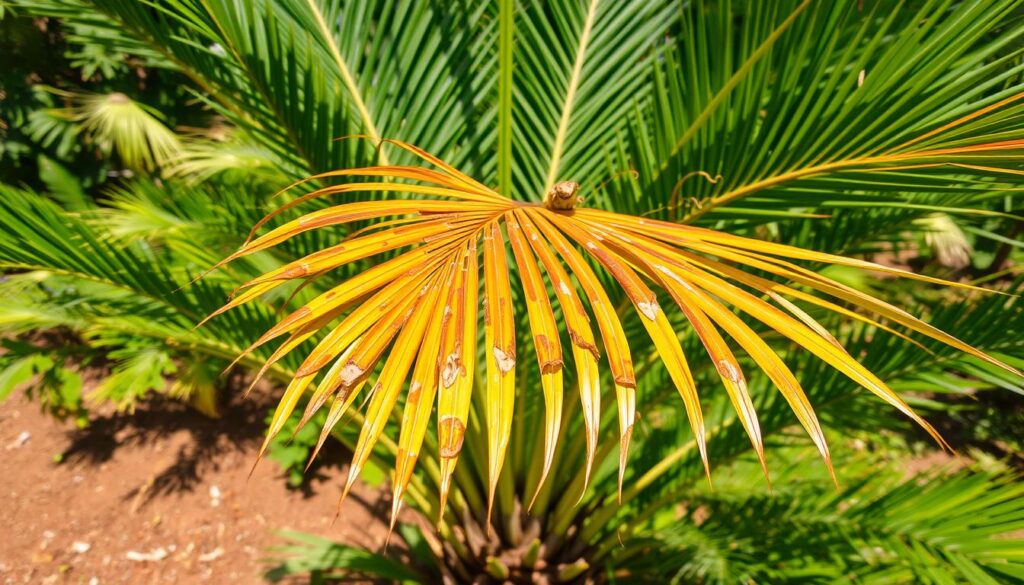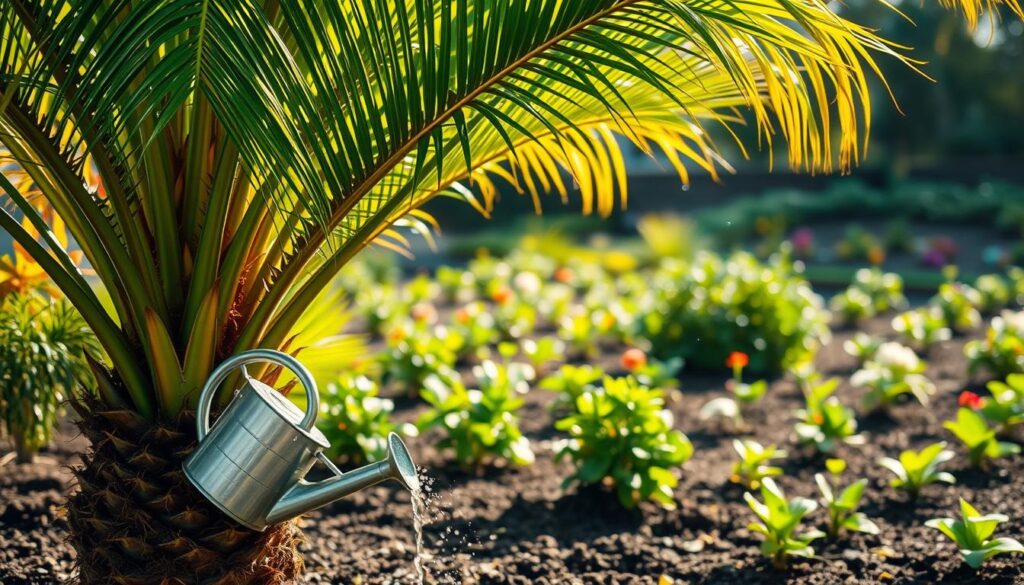Palm trees add a touch of warmth to any landscape. But when their fronds turn brown, it’s a sign of trouble. Brown fronds can be due to not enough water, lacking nutrients, or fungal diseases. Thankfully, with the right care, brown palm leaves can turn green again.
Identifying why your palm tree fronds are turning brown is key. It shows your tree is under stress. Knowing the cause helps you fix the problem.
Table of Contents
Key Takeaways
- Palm tree fronds turning brown can be caused by inadequate watering, nutrient deficiencies, and fungal infections.
- Soil analysis is vital to identify nutrient deficiencies and guide fertilizer use.
- Overwatering can lead to yellowing and eventual root rot, while underwatering can cause brown tips on palm leaves.
- Professional arborists can assist with diagnosing palm issues and offer consultancy services.
- With proper care and attention, brown palm leaves can turn green again, and the tree can regain its health and vitality.
- Regular soil flushing and fertilization during the active growing seasons can help prevent palm tree fronds from turning brown.
Understanding Palm Trees and Their Fronds
Palm trees come in over 2,600 species worldwide. Each has its own palm tree types and features. Their fronds, which vary in shape, size, and color, are key to the tree’s health. Proper care is vital to keep these fronds healthy. They help with photosynthesis and protect the tree from harsh weather.
Knowing the importance of healthy fronds is key to a palm tree’s well-being. Different palm trees have different frond types. For example, the Areca palm, Bamboo palm, and Parlor palm each have specific needs for their fronds.
Overview of Palm Tree Types
There are many palm tree types, each with its own needs. Some grow well indoors, while others prefer the outdoors. It’s important to know the different types and their needs to keep the fronds healthy.
Importance of Healthy Fronds
Healthy fronds are vital for a palm tree’s health. They help with photosynthesis and protect the tree from extreme weather. Without them, the tree can’t survive, making care and maintenance essential.
Common Causes of Browning Fronds
Browning fronds can worry palm tree owners. They might show the plant is not healthy. Things like extreme temperatures, drought, and too much water can cause this. Also, nutrient deficiencies can lead to browning fronds. Palms need the right nutrients to grow well.
Some common reasons for browning fronds include:
- Extreme temperatures
- Drought
- Excessive watering
These issues stress the plant, causing fronds to turn brown. Also, nutrient deficiencies can be fixed with fertilization. This helps the plant grow strong and keeps fronds from browning.
Other reasons for browning fronds are pests and diseases. Keeping an eye on the plant and treating problems quickly can stop fronds from turning brown. This helps keep the palm tree healthy.
Identifying Nutrient Deficiencies
Palm trees need essential nutrients like nitrogen, phosphorus, and potassium to stay healthy. Nutrient deficiencies can show as yellow or brown fronds, slow growth, and less fruit. Knowing the key nutrients for palm trees and their roles is key to spotting these issues.
A soil test can pinpoint nutrient deficiencies. For example, a potassium shortage can turn older fronds yellow or brown. Nitrogen deficiency might make all frond surfaces the same color.

- Yellowing or browning fronds
- Stunted growth
- Reduced fruit production
- Specific patterns of discoloration, such as yellowing between leaf veins or at the tips of the leaves
Understanding the key nutrients for palm trees and their symptoms helps gardeners fix problems. This ensures palm trees get what they need for growth and health.
| Nutrient | Symptoms of Deficiency |
|---|---|
| Potassium | Yellowing or browning of older fronds |
| Nitrogen | Uniform discoloration across the entire surface of the fronds |
| Magnesium | Yellowish-colored bands at leaf edges with a green center |
Watering Practices and Palm Trees
Proper watering is key for palm tree health. Too much or too little water can harm the tree. The right amount depends on the palm type, climate, and soil. Watering practices must match each palm’s needs for the best health.

To find the perfect watering schedule, check the soil moisture. A moisture meter is very helpful. Also, use a potting mix that drains well to avoid waterlogged soil.
Importance of Proper Watering
Good watering habits are critical to avoid problems like brown tips on palm fronds. These issues often come from too little water, too much fertilizer, or cold. The right water amount helps keep palm trees healthy.
Signs of Overwatering vs. Underwatering
Knowing the signs of too much or too little water is important. Overwatering shows as yellow or droopy leaves. Underwatering causes brown or crispy leaves. Spotting these signs helps adjust watering to keep trees healthy.
By following proper watering practices, palm tree owners can keep their trees thriving. With the right water, palm trees flourish, bringing joy and benefits to their owners.
The Role of Sunlight in Palm Health
Palm trees need bright, indirect sunlight to grow well. Some can handle full sun or shade, based on where they come from. It’s key to give them the right sunlight to stay healthy.
Ideal light conditions are important for palms. Direct sunlight can burn their leaves. Not enough sunlight makes them weak. Finding the right balance is vital for their growth.
Every palm tree is different when it comes to sunlight. Some love full sun, while others prefer shade. Knowing what your palm needs helps it stay healthy.

To get the sunlight right, you can use shading or pruning. A sheer curtain can soften intense sunlight. A south-facing window is great for sun-loving palms. By understanding sunlight’s role, you can help your palm thrive.
| Palm Tree Species | Light Requirements |
|---|---|
| Areca Palm | Bright, indirect sunlight |
| Parlor Palm | Low to medium sunlight |
| Pygmy Date Palm | Full sun to partial shade |
Pest Management for Palm Trees
Palm trees can face many pests like spider mites, mealybugs, and scale insects. These pests can harm the health and look of the trees. It’s important to manage pests well to prevent damage.
Regular checks and quick action are key to spotting common pests that harm palm trees.
Mealybugs, spider mites, and scale insects are common pests of palm trees. They can cause leaves to turn yellow or brown and slow down growth. To fight these pests, using insecticidal soap, neem oil, and integrated pest management is essential.
To find pests, look for white, cottony patches or tiny dots on the plant. Regularly checking your palm trees and acting fast can stop infestations and keep them healthy.
Some good ways to manage common pests include:
- Using insecticidal soap to control mealybugs and spider mites
- Applying neem oil to prevent pest infestations
- Implementing integrated pest management strategies to minimize damage and prevent infestations
Managing Diseases in Palm Trees
Palm trees can get sick from fungal and bacterial infections. Keeping an eye on them and staying clean can stop disease spread. Knowing the common diseases in palm trees is key for good disease management.
Diseases like diamond scale, Fusarium wilt, and lethal bronzing can harm palm trees. They can turn leaves brown or yellow and can be deadly. To fight these, pruning sick leaves and using fungicides or bactericides is important.
Good hygiene is vital to stop disease spread. This means cleaning pruning tools and not watering too much. These steps help keep palm trees healthy and stop common diseases.
- Regular monitoring for signs of disease
- Practicing good hygiene, including disinfecting pruning tools
- Avoiding overwatering, which can contribute to the spread of disease
- Applying fungicides or bactericides as needed
By using these methods, gardeners can keep palm trees healthy. Good disease management is essential for palm trees’ health and looks. It also stops common diseases from spreading.
Seasonal Changes and Their Impact
Palm trees, like many other plants, face challenges from seasonal changes. These changes can cause stress due to temperature, humidity, and light. This stress can lead to problems like browning fronds and slower growth.
It’s important to know how seasonal changes affect palm tree health. For example, during the dry season, palm trees need more water to avoid moisture stress. In the wet season, they might be more at risk for root rot and diseases.
Preparing Your Palm for Seasonal Shifts
To reduce the impact of seasonal changes on palm tree health, take proactive steps. This includes:
- Adjusting watering schedules to match the changing seasons
- Providing protection from extreme temperatures and weather conditions
- Pruning dead or damaged fronds to maintain the tree’s appearance and promote healthy growth
By understanding the effects of seasonal changes on palm tree health and preparing your palm, you can minimize stress and prevent damage. With the right care, your palm tree can thrive all year, no matter the season.
Maintaining Overall Palm Tree Health
Keeping your palm tree healthy is key to its long life. By following the best care and maintenance practices, you can ensure your tree stays strong. This helps prevent problems like browning fronds.
Best Practices for Care and Maintenance
Regular fertilizing, proper watering, and enough sunlight are vital for your palm tree’s health. Don’t overdo it with fertilizers or water, as this can harm your tree. Prune your palm tree carefully, removing no more than 30% of leaves at once to avoid stressing it.
When to Consult a Professional
If you’re not sure how to care for your palm tree or think there’s a problem, get help from a pro. A professional arborist or horticulturist can give you advice that fits your tree’s needs and your area’s climate and soil. Their help can prevent bigger issues from arising.
Frequently Asked Questions
What do I do when my palm tree leaves turn brown?
Brown leaves on a palm tree usually mean something is off with its care—like underwatering, overwatering, or a lack of nutrients. First, check the soil. If it’s too dry, your palm needs water. If it’s soggy, you might be overwatering. Also, look for pests or signs of disease. A slow-release fertilizer made for palms can help if the issue is a nutrient deficiency.
Should I cut off brown palm fronds?
Yes, but only if they’re completely brown and dry. If a frond still has some green, leave it alone—it’s still helping the tree by producing energy. When cutting, use clean, sharp pruning shears and avoid cutting too close to the trunk.
What does an overwatered palm tree look like?
An overwatered palm tree might have yellowing leaves, soft or mushy roots, and droopy fronds. If the soil stays wet for too long, root rot can set in, which is a serious problem. Make sure your palm is in well-draining soil, and let the top few inches dry out before watering again.
Can brown palm fronds turn green again?
Nope—once a palm frond turns brown, it’s done. The best thing you can do is focus on preventing more browning by adjusting your watering schedule, checking for pests, and ensuring the palm gets enough nutrients.
Can brown leaves turn green again?
No, brown leaves—on any plant—are dead and won’t turn green again. If only the tips are brown, you can trim them off, but if a whole leaf is brown, it’s best to remove it so the plant can focus on healthy new growth.
How do you revive a dying palm tree?
First, figure out what’s causing the problem. Check the soil moisture—too dry? Water it. Too wet? Let it dry out. Make sure the palm is getting enough light, but not too much direct sun if it’s a shade-loving variety. If you suspect a nutrient deficiency, use a balanced palm fertilizer. Trim off dead fronds, but don’t over-prune. If root rot is an issue, you may need to repot or improve drainage.

